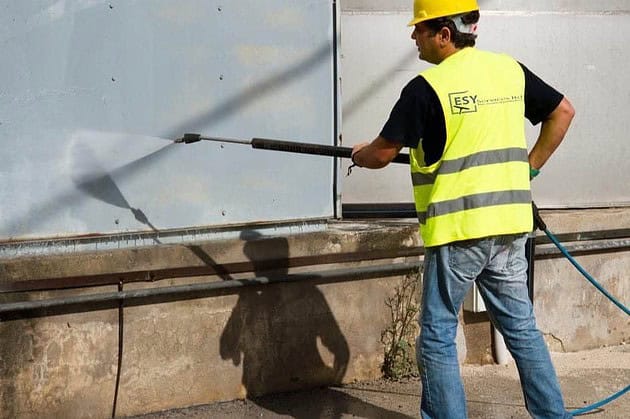There are many benefits from cleaning your façade from time to time. By taking this simple action, you shall be impressed by the results. It makes a building look fresh. It is not only a way to give your house a facelift (which generally increases the value of your property), but a great way to maintain your house. Did you know that depending on the type of deposit and brick used, dirt can lead to all kinds of harmful effects?
For example, dirt on the façade will retain moisture. This will create a good environment for organisms that secrete acids, which will harm the bricks. for this reason, just like anything else, it is important to clean the facade of your home
We discussed this with Cleanify.at – who provide facade cleaning in Vienna (Fassadenreinigung Wien) and between a discussion with them and our own research this is what we came up with.

What Can You Do Yourself And What Not To Do While Cleaning Façade?
This is a simple but tricky question for many people. The goal is, what do you want to do yourself? First, you need to understand that cleaning the exterior part of your building is a dirty job and not worth the risk. That is because apart from the heights you must clean, aggressive products (chemicals) are used to clean it. These are products that need to be handled carefully. Some of these chemicals require municipal permits.
The best thing is that a façade cleaning company has all the legal permits needed to deliver high-quality work. However, this comes with a high price tag. The good news is that there are some pollutants that you can handle yourself. For example, you can choose to buy or rent a sandblaster and pressure washer. You can use cleaning chemicals that are readily found on the market. Simple household products can be used as well.
Façade Cleaning Steps – What You Can Do Yourself
Step 1: Determining The Type Of Pollutant
There are many types of pollutants that can affect your façade. Before you begin cleaning them, it is wise to identify them. Below are some of the most common types of pollutants you can get:
- Moss – Moss grows in the joints between pavers. To clean moss, steam or chemical cleaning is best. However, you will need to do extra treatment using moss-killing products.
- Green haze – Algae growth causes green haze to form on the façade. To remove this, you need to use steam cleaning with a mild chemical to remove the green layer. After cleaning, it is wise to treat the area with products that discourage algae growth.
- Black Deposits – Soot elements from the chimney, factory, and traffic flow can cause unpleasant dark deposits on the façade. The difficult part of it all is that black deposits get deeply rooted, which is why chemical cleaning is the best option.
- White Deposits – Chemical processes cause white deposits to appear in the bricks and mortar. Lime, saltpeter, and salt are often the main culprits. Salt and Salpeter are the most harmful to the building. The white deposits can be touched by scrubbing with special products or sandblasting.
- Grey Deposits – Rain or water are the common causes of grey deposits. It results from the oxidation process that goes on in the bricks. Sandblasting is the only way to remove gray deposits.
Step 2: Identify The Type Of Stone And The Best Façade Finishing For It
It is important to note that not all cleaning methods are suitable for any surface. For example, stone and concrete can take a beating through cleaning methods like sandblasting. However, soft and porous materials like sand and lime cannot be treated this way and require friendlier approaches.
Step 3: Cleaning The Façade
After choosing your cleaning method, it is wise to first practice on a part of the wall that is not visible. For example, if you are using the sandblasting cleaning method, you can test the results first to test its strength. Allow it to rest for one day to see the results before you continue.
Cleaning Method Tips For Various Methods
- Chemical Cleaning – This cleaning method helps remove the green layer that is formed by algae and moss. The best thing is that you can make your own mix. To make your own mix, just mix some dense vinegar or bleach and use the brush. Use the solution and a brush to brush the wall and allow it to soak. After this, rinse with a garden hose or pressure washer.
- Pressure Washer Cleaning – Some deposits can be easily removed with a pressure washer. That is because the pressure washer is fitted with powerful jets that not only dislodge dirt but also leave the surface clean. As you are using a pressure washer, ensure that you do not damage the window frames. Do not direct the washer pressure too close to the joint.
Note: After you are done cleaning, protect the façade with water repellent to protect the stones against potential weather influences.
- Steam Cleaning – Steam cleaning is a much friendlier alternative to high-pressure cleaning. Steam is great for loosening deposits. The other option is combining both pressure washers that can deliver steam at 140°C. The combination of both helps prevent damaging the walls. Steam cleaning is recommended for natural and limestone facades.
- Sandblasting – if all other cleaning methods fail, sandblasting will definitely help. Sandblasting is an effective but aggressive method and can uncover latent defects that may require a latent structural warranty to rectify. It is recommended for deep-rooted and persistent pollution like old plaques, graffiti, and others. However, it is important to note that Sandblasting can easily damage the stone and the joints. If you choose this method, it is wise that you consider using grout and impregnating the façade. Do not forget to protect yourself by wearing safety glasses and a dust mask.














